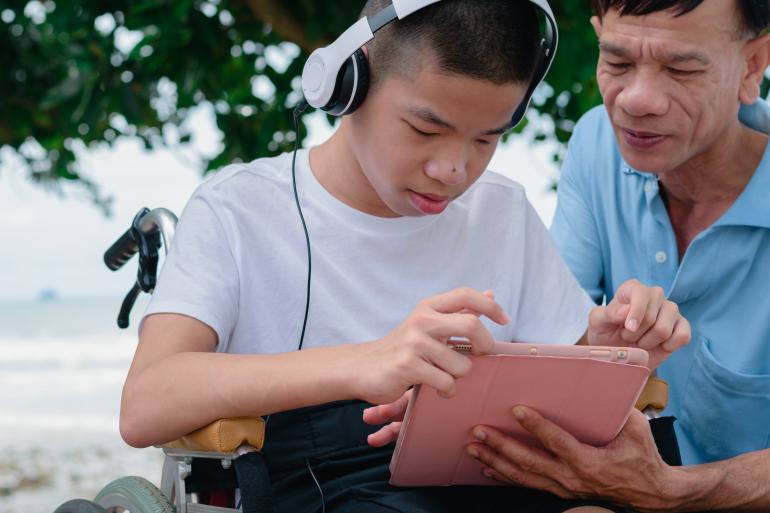Reducing gender inequalities in education systems in Africa
IIEP places gender equality at the heart of education sector strategies and practices and offers technical support on gender and education, training and capacity building, and knowledge production and sharing.
Despite progress observed over the last 25 years, girls' education still faces numerous and cumulative obstacles. Related issues concerning boys’ education are no less complex, and gender inequalities affect not only students but also teachers and administrative staff.”
On the ground, IIEP’s support results in transversal integration of the gender dimension into the elaboration, implementation, and monitoring of education policies. IIEP also designs, coordinates and delivers high-level training courses aimed at building professional and institutional capacity on gender issues in education. A major part of this work is accomplished through IIEP’s role as the technical lead of the Gender at the Centre Initiative (GCI). First launched in 2019 within the framework of the G7, GCI strives to advance gender equality in and through education by strengthening the capacity of education professionals. Throughout the programme, a variety of resources and methodologies are available to facilitate understanding of the issues and challenges, and assist in decision-making and gender-sensitive budgeting.
GCI focuses on 8 sub-Saharan African countries
38 participants joined the University 2020, a special training course on gender-responsive planning
16 francophone African countries represented in the course; 56% women
Disability-inclusive education

Children and youth with sensory, physical, or learning disabilities are two-and-a-half times more likely than their peers to never go to school. Planning for their diverse learning needs and setting up the required legal and support structures are invaluable for countries as they shift towards inclusion.”
To support countries with inclusive education, IIEP has joined forces with UNICEF to train education officers worldwide on the fundamentals of disability-inclusive educational planning. Four courses, lasting nine weeks each, have taken place in Eastern and Southern Africa, francophone Africa, South Asia, and East Asia and the Pacific since 2020. IIEP is also conducting case studies in Colombia, Bangladesh, and the Republic of Mauritius, on emerging practices in inclusive digital learning in collaboration with the UNESCO Institute for Information Technologies in Education.
166 participants completed the training
Participants came from ministries of education and UNICEF country offices
600 participants in two webinars
Rapid assessments in Mauritius and Rwanda are exploring the impact of COVID-19 on pupils with disabilities. Interviews with more than 50 educators identified lessons learned and good practices, helping to articulate policy recommendations to encourage innovative and pervasive use of information communication technologies and distance learning solutions.
Planning education for displaced learners
A refugee child can spend years living in exile –sometimes the entire duration of their education. Given this reality, IIEP assists ministries of education to integrate refugees and displaced learners into national education systems. This work is central to IIEP’s commitment to the Comprehensive Refugee Response Framework, a wide-ranging pact adopted by all 193 Member States of the United Nations in 2016 to provide greater support to refugees and their host countries. Recent work in Ethiopia illustrates the breadth and depth of recent activities: IIEP researched teacher management in refugee camps and led training courses to strengthen the coordination, planning capacity, and management of education in refugee and host communities. For the first time, refugee education was also included in its latest education sector plan, a key milestone in the recognition of refugee education needs at the federal level.
The integration of refugees into national education systems is a long-term, multifaceted process, but one which is embedded in global agreements such as the Global Compact on Refugees. IIEP contributes to building the evidence base to better understand the needs and challenges faced by host and refugee communities, and recognizes that the multiple pathways to inclusion each have specific implications for educational planning.”
To help integrate refugee and displaced learners into national education systems from the outset, IIEP supports countries with:
- Costing and financing education for displaced learners
- Enhancing supervision and inspection systems in refugee settings
- Planning for the integration of refugees in national sector plans
- Knowledge sharing and global advocacy
Leaving no one behind after the pandemic
In 21 Latin American countries, students from the richest 20% of the population are –on average– five times more likely to complete upper secondary school than students from the poorest 20%. COVID-19 has now deepened the education gaps in the region, which was already the most unequal in the world. These data are taken from the first UNESCO Global Education Monitoring (GEM) Report dedicated to Latin America and the Caribbean. IIEP was responsible for hosting a debate among regional authorities on the results of the study. The 2020 edition of the Regional Forum on Education Policy explored the obstacles that continue to exist in the region to ensure quality education for all and identified concrete lines of action to promote more inclusive education systems. This was also the first edition of the forum to welcome government officials from non- Spanish-speaking Caribbean States.
111 representatives from 26 countries in Latin America and the Caribbean
More than 40 policy recommendations
We need more and better education in our region, because education is an excellent antidote to inequality."
